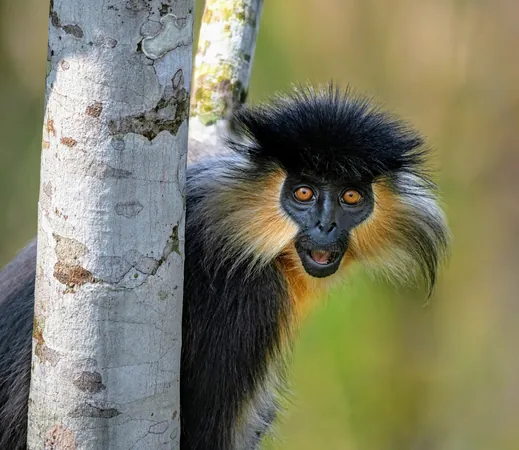
Alarming Hybridization Among Endangered Langurs Signals Potential Extinction Crisis
2024-09-28
Author: Ming
Discovery of Hybridization in Bangladesh
Led by PhD student Tanvir Ahmed from the German Primate Center, a research team has embarked on a crucial five-year study from 2018 to 2023 to investigate langur populations in northeastern Bangladesh. Their findings are alarming: out of 98 langur groups analyzed, they discovered eight mixed groups consisting of both Phayre's and capped langurs, raising serious concerns about the future of these species.
In three of the identified mixed groups, researchers observed individuals that displayed unique characteristics merging traits of both langur species. Genetic testing later confirmed that these hybrids were produced by a capped langur mother and a Phayre's langur father, signifying a rare occurrence of hybridization due to encroaching threats to their habitats.
The Implications of Hybridization
Hybridization, while a natural phenomenon in some species, poses a risk of eroding the genetic integrity of endangered species. As Tanvir Ahmed articulated, “The existence of fertile hybrids is particularly alarming because it suggests that gene flow between these two endangered species could irreversibly affect their future genetic composition.” Christian Roos, a co-author and lead scientist, noted the broader implications: "This is not just a local problem. When habitats are destroyed, animals mix unnaturally, which can lead to the extinction of one or both species."
The interaction between these two langur species highlights the profound ripple effect caused by human activities like deforestation, hunting, and trapping—actions that not only reduce species populations but also lead to unintended consequences like hybridization.
Forest Conservation: A Race Against Time
The study underscored that well-protected forests harbor larger populations of langurs. Unfortunately, even these protected areas are often fragmented and insufficient to ensure the survival of these vulnerable primates. Ahmed stressed the need for immediate action, declaring forest conservation a national priority to prevent the possible extinction of both Phayre's and capped langurs and to safeguard Bangladesh's rich biodiversity.
The urgency of the situation cannot be overstated. With fewer than 500 Phayre's langurs and around 600 capped langurs remaining, their survival depends heavily on effective conservation strategies. These must encompass not only habitat preservation but also tackling the threats of deforestation and illegal hunting.
Collaborative Conservation Efforts Needed
To secure the future of these endangered langurs, a holistic approach involving local communities is paramount. Education and awareness campaigns can foster a culture of conservation, while stronger laws and enforcement mechanisms are vital to protect these primates from habitat destruction.
Furthermore, the implications of this research extend beyond Bangladesh, calling for a global collaborative effort in primate conservation. Establishing international partnerships with organizations adept in research and conservation would facilitate the sharing of resources, knowledge, and funding aimed at preserving these species.
Ahmed's focus is now shifting to a comprehensive genetic analysis of langur populations within the context of climate change vulnerability. This research is expected to shape an effective action plan that can enhance the survival of these endangered species while contributing to the overall health of their ecosystems.
Conclusion
The findings have been detailed in the International Journal of Primatology, serving as a critical wake-up call for conservationists and policymakers alike about the precarious situation of langurs and the urgent need for protective measures.
Don't overlook this critical conservation crisis—act now!





 Brasil (PT)
Brasil (PT)
 Canada (EN)
Canada (EN)
 Chile (ES)
Chile (ES)
 España (ES)
España (ES)
 France (FR)
France (FR)
 Hong Kong (EN)
Hong Kong (EN)
 Italia (IT)
Italia (IT)
 日本 (JA)
日本 (JA)
 Magyarország (HU)
Magyarország (HU)
 Norge (NO)
Norge (NO)
 Polska (PL)
Polska (PL)
 Schweiz (DE)
Schweiz (DE)
 Singapore (EN)
Singapore (EN)
 Sverige (SV)
Sverige (SV)
 Suomi (FI)
Suomi (FI)
 Türkiye (TR)
Türkiye (TR)